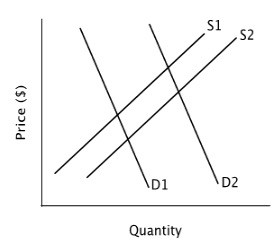College students who increase their human capital by acquiring the skills required for certain occupations typically earn higher incomes than high school graduates. This is called:
A. the learning effect of a college education.
B. the signaling effect of a college education.
C. the discriminatory effect of a college education.
D. None of these
Answer: A
You might also like to view...
The demand curve for U.S. dollars slopes downward because as the dollar ________ U.S. goods become ________ expensive to foreign residents, so they purchase fewer U.S. goods, and the quantity of dollars demanded decreases
A) appreciates; more B) appreciates; less C) depreciates; more D) depreciates; less
Refer to the accompanying figure. Assume demand remains unchanged at D1. If supply shifts from S1 to S2, then the equilibrium price will ________ and the equilibrium quantity will ________.
A. rise; rise B. rise; fall C. fall; fall D. fall; rise
In long-run equilibrium, a monopolistically competitive firm achieves:
A. productive efficiency but not allocative efficiency. B. allocative efficiency but not productive efficiency. C. neither allocative efficiency nor productive efficiency. D. productive and allocative efficiency.
The Celler-Kefauver Act outlawed predatory pricing.
Answer the following statement true (T) or false (F)